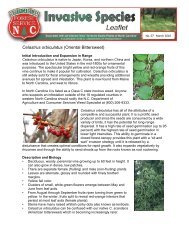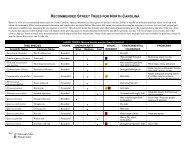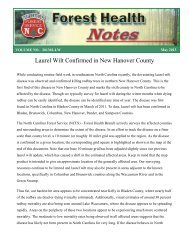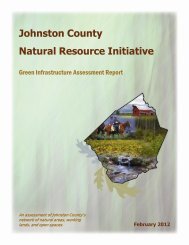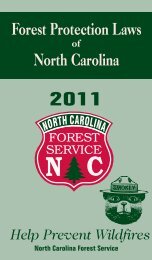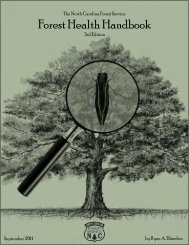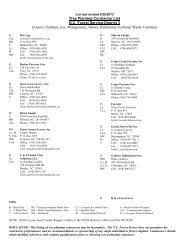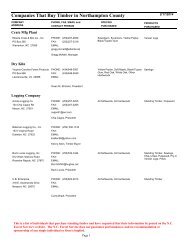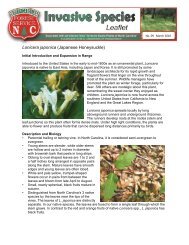Northampton County Honors the Morey's - NC Forest Service
Northampton County Honors the Morey's - NC Forest Service
Northampton County Honors the Morey's - NC Forest Service
- No tags were found...
Create successful ePaper yourself
Turn your PDF publications into a flip-book with our unique Google optimized e-Paper software.
15Evidence of <strong>the</strong> presence of <strong>the</strong> emerald ashborer can be seen on this green ash in <strong>the</strong>Greenbrier section of <strong>the</strong> Great Smoky MountainsNational Park Tuesday, Nov. 27, 2012.Photo by Adam Brimer—Knoxville NewsSentinelA tiny hole created by an emerald ash borercan be seen in <strong>the</strong> bark of a green ash in <strong>the</strong>Greenbrier section of <strong>the</strong> Great Smoky MountainsNational Park Tuesday, Nov. 27, 2012.Photo by Adam Brimer—Knoxville NewsSentinelPark biologist Glenn Taylor holds a vial containingan emerald ash borer specimen in <strong>the</strong>Greenbrier section of <strong>the</strong> Great Smoky MountainsNational Park Tuesday, Nov. 27, 2012.Photo by Adam Brimer—Knoxville NewsSentinelinch in diameter, and that <strong>the</strong> beetles typically start at <strong>the</strong> top and work <strong>the</strong>irway down."When you see woodpecker holes down this low on <strong>the</strong> trees, <strong>the</strong> infestation ispretty advanced," he said. "These trees are on <strong>the</strong>ir way out. Some already lookdead."The emerald ash borer is just <strong>the</strong> latest in a series of exotic-invasive insects toplague <strong>the</strong> Smokies. In 1963 <strong>the</strong> balsam woolly adelgid was discovered onMount Sterling and eventually wiped out an estimated 90 percent of <strong>the</strong> park'sFraser firs. More recently, park managers have had to contend with a tiny nonnativeinsect called <strong>the</strong> beech scale, whose feeding habits cause <strong>the</strong> spread of afungal disease that eventually kills <strong>the</strong> beech tree.A decade ago <strong>the</strong> hemlock woolly adelgid — an Asian import that feeds onhemlock trees — was discovered inside <strong>the</strong> park near Fontana Dam.The park is home to two species of ash, green and white, with green ash occurringat lower elevations and white ash distributed all <strong>the</strong> way from low elevationsto around 5,200 feet.Park scientists say <strong>the</strong> trees are ecologically important for a number of reasons."The seeds of ash trees provide food for small animals and large birds, and <strong>the</strong>flowers are important for pollinators," said Kristine Johnson, supervisory foresterfor <strong>the</strong> Smokies.In recent years state and federal officials have hung more than 4,500 purple boxtraps in a 50-mile radius of Knoxville to track <strong>the</strong> range of <strong>the</strong> emerald ash borerinfestation. The beetles are notorious firewood hitchhikers. In <strong>the</strong> Smokies,campers are prohibited from bringing any type of firewood (not just ash) fromareas that have been quarantined for emerald ash borer or o<strong>the</strong>r destructivepests.Park scientists say <strong>the</strong> next invasive insect threat on <strong>the</strong> horizon is <strong>the</strong> Asianlong-horned beetle, a wood borer that has spread to sou<strong>the</strong>astern Ohio, some300 miles from <strong>the</strong> Smokies.Taylor said <strong>the</strong> park's strategy for combating <strong>the</strong> emerald ash borer will parallel<strong>the</strong> steps taken against <strong>the</strong> hemlock woolly adelgid.Initially, ash trees in campgrounds and along roads will be treated with systemic insecticides (<strong>the</strong> same chemicals usedon <strong>the</strong> hemlock woolly adelgid) to maintain public safety. The next priority will be on saving high-value ash stands in <strong>the</strong>backcountry using chemical treatments combined with <strong>the</strong> release of two species of stingless, parasitic wasps that are nativeto Asia and feed on emerald ash borer larvae.(Continued from page 14)Funding to control <strong>the</strong> emerald ash borer will come mostly from <strong>the</strong> U.S. <strong>Forest</strong> <strong>Service</strong>."There never will be a complete eradication," Taylor said. "We want to protect <strong>the</strong> public and save as much of our oldgrowthash as we can. If we do nothing, we could lose 99 percent of our ash trees like <strong>the</strong>y've seen in Ohio."



